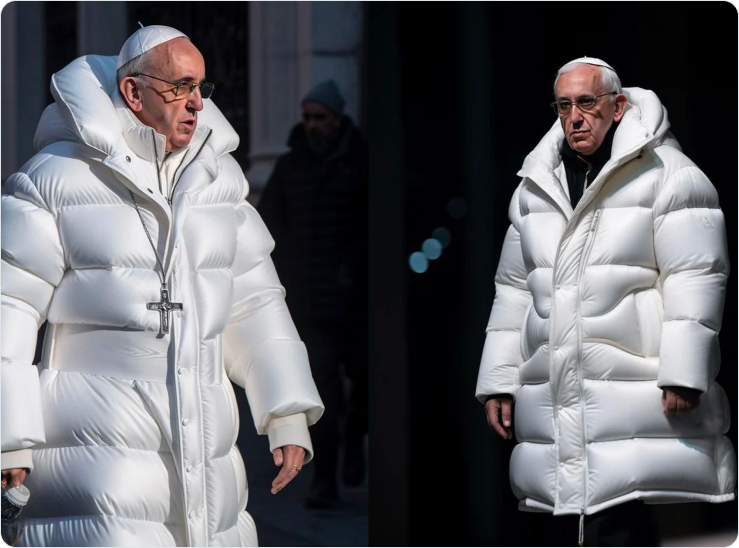
How to Detect AI-Generated Images
Keywords: Free AI detector, AI image detection tools, AI content detector, AI image detector, AI detection tools, AI content detection, AI-generated content, AI image checker, Top AI content detection tools.
The above photo depicts the Pope in a jacket, but it isn’t real. AI deep fakes are starting to become a big issue. From playful depictions to harmful deepfakes, bad actors have exploited AI for nefarious activities. However, you can protect yourself and your organisation's reputation.
In this article, we will discuss AI image generation, how to detect AI-generated images and AI image detectors.
AI Image Generation, The Ethical Question
At first, it was good, AI art was the rave. Then copyright issues started to pop up, followed by the emergence of deepfakes. While AI models like Midjourney, Stable Diffusion, or DALL-E could generate hyperrealistic images for content creation, hyperrealism also became its downfall.
AI-generated imagery continues to spark debates on issues of ethics. Many argue that AI images infringe on copyrights, are a threat to human creativity and are a burden for the artists who will not profit from the work used to train these AI models. For the promoters of AI, the argument is that AI is not entirely autonomous and depends on human input, guidance, and interpretation and that this collaboration can only enhance human creativity.
For curiosity's sake, how are AI images generated?
How AI Images are Generated
AI image generators use machine learning (ML) technologies to recognise image patterns, objects, characters and other characteristics and to develop new images based on prompts. The AI model advanced deep learning algorithms compare text prompts with similar image reproduction in its vast database and use that information to reproduce imagery that fits the prompt.
So although AI image tools can create stunning images quickly, it still requires human creativity to formulate the right text prompts and create unique works.
How to Detect AI-Generated Images
AI-generated images can be difficult to detect due to their increasingly realistic appearance. However, there are certain telltale signs you can look out for to determine if an image is AI-generated or a product of artistic ingenuity.
Physical Examination
Examine the image closely for any artefacts or anomalies that may indicate manipulation. Look for unnatural edges, inconsistencies in lighting or shadows, watermarks or repeating patterns that suggest cloning or copying. You should also look out for semantic Inconsistencies. AI-generated images may sometimes contain questionable elements that are not realistic. For example, an image of a person with an unrealistic pose or proportions may indicate that it was generated by AI.
Some clues to look out for in AI images include:
1. Text: Most AI image models can’t write text yet. So, images generated with text components are most likely to be gibberish. Words on AI images will appear as gibberish and incoherent.
2. Painted parts: Although AI can produce seemingly flawless images at first glance, there are likely to be some inconsistencies in the tone. Look out for parts that might look like they were painted with a brush instead of being photographed.
3. Skin texture: Most AI photographs look smooth and flawless, but that’s not natural. Real human skin has marks, freckles, wrinkles and inconsistencies. Look out for those to determine if the images are real or not.
Metadata Analysis
Check the metadata of the image to see if it contains any information about the software or tools used to create it. AI-generated images may lack metadata typically found in images captured by phones or cameras.
Reverse Image Search
Use reverse image search engines like Google Lens to see if similar images exist online. AI-generated images may not have any matches or may appear in unusual contexts.
Use AI image detection tools
AI image detectors are AI tools that use advanced algorithms and image analysis to determine if an image was generated by AI or created by humans. The Image tracking model of an AI image checker combines layers of artificial neurons and large datasets of images to learn and track examples of inputs and outputs of desired tasks.
The AI image detection process can include several tasks, but here’s a glimpse into how most AI image checkers work.
1. Object Detection: Identify and locate objects within an image. This is achieved through neural networks trained on extensive datasets or vision APIs designed for pattern recognition.
2. Image Segmentation: Divide an image into regions based on its content, such as “sky,” “grass,” or “water.” This can be done using computer vision techniques or convolutional neural networks (CNNs) that learn from data. Image segmentation helps in understanding the context and boundaries within an image, enhancing the accuracy of detection.
3. Real-time video: AI image detectors can analyze and process video streams in real-time, detecting faces, emotions, and actions. This is achieved using computer vision techniques and neural networks that learn from data. By leveraging these advanced technologies, AI image detectors can provide immediate and accurate insights that make them invaluable applications in security, entertainment, and other industries.
AI image detection tools like Detectify AI leverage its advanced mechanics to deliver consistently accurate results.
Detectify AI
Detectify AI is an advanced, AI-powered detection tool designed to analyse text, images, and audio to uncover the hidden fingerprints of automated content generation. This cutting-edge tool leverages sophisticated algorithms to identify patterns and anomalies indicative of AI-generated content, ensuring the authenticity and originality of various media types. Detectify AI offers both a free version and a paid pro version. This tool is particularly useful for individuals and organizations seeking to maintain the integrity of their content and protect against the rising threat of AI deepfakes and other forms of automated content manipulation.